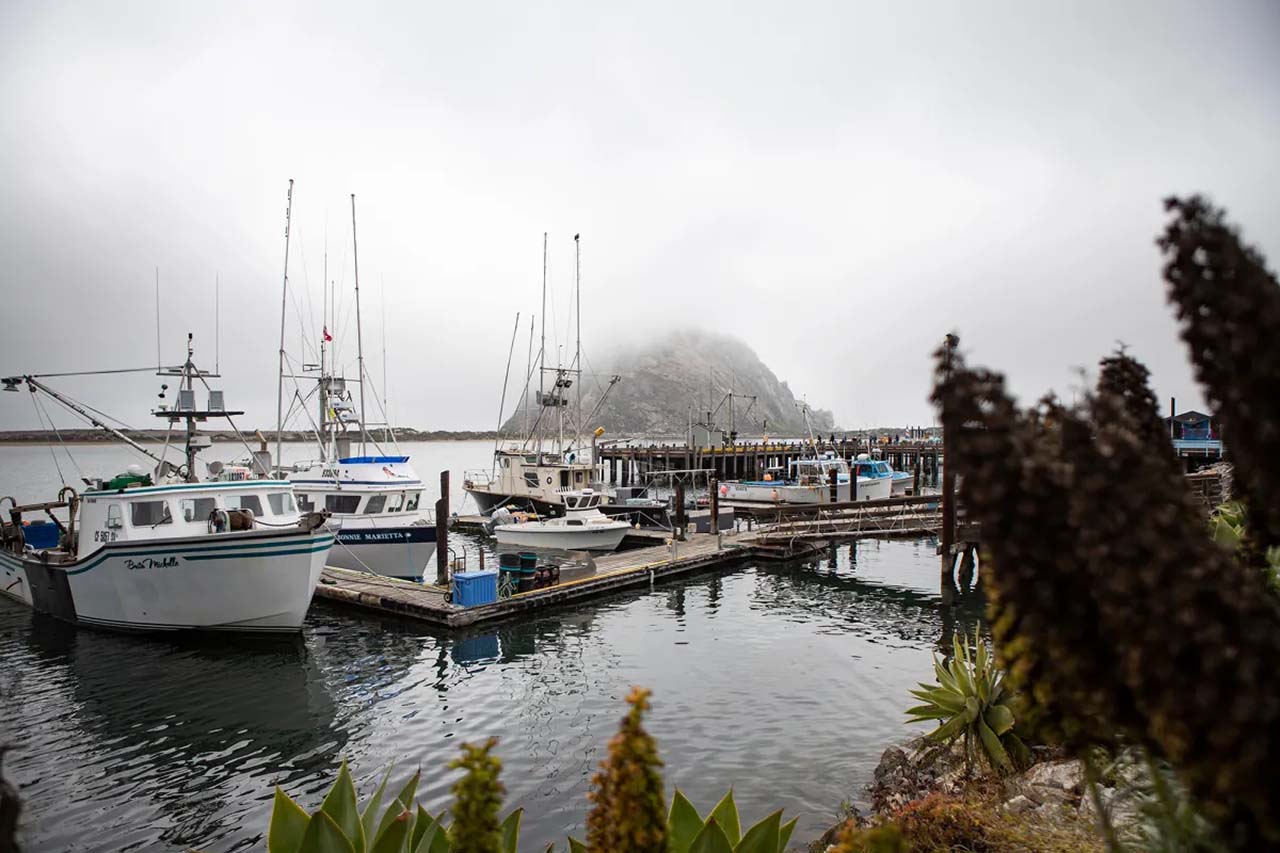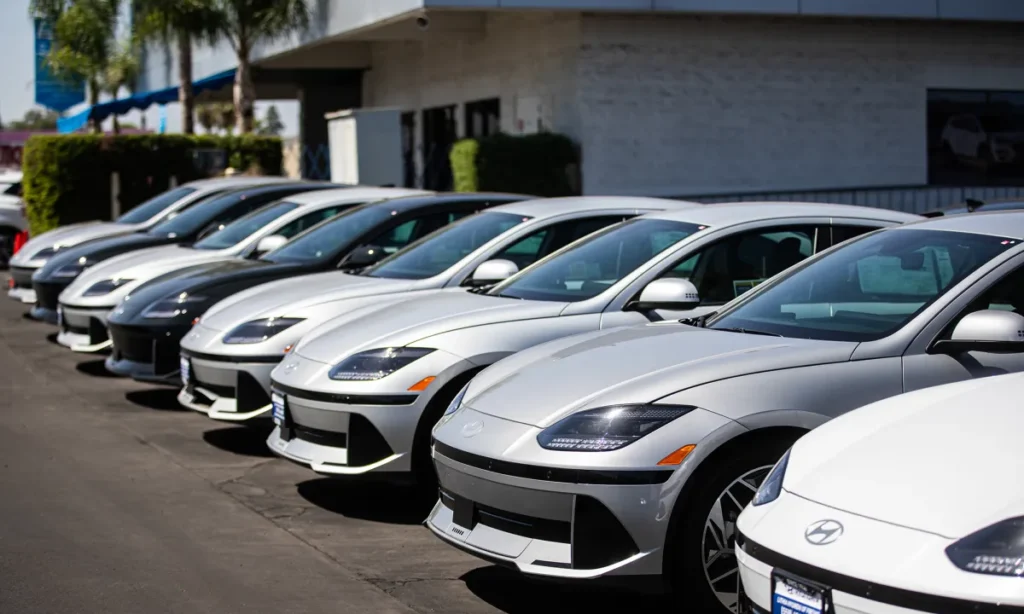Share
MORRO BAY — Joey Racano used to have a dining room table. Now the sunlit nook off the family kitchen more often than not serves as a conference room. The table is covered with maps, thick binders bulging with tech reports, towers of meeting minutes, abandoned coffee mugs — the accumulation of years of community vigilance.

Julie Cart
CalMatters
On this day, his home is a lively place where a handful of locals are discussing one of California’s most complex and audacious initiatives — loading the Pacific Ocean with sprawling wind farms that float 20 miles from shore.
To some, it’s an exciting endeavor that will power California’s carbon-free electricity grid of the future. To others, including the people around the table, the construction of untried technology off the coast carries too many risks and unknowns.
“This is just another attempt to industrialize the coast,” said Rachel Wilson, who lives in Cayucos, a tiny, old-fashioned beach town, and regularly attends public meetings about the wind projects. “I can just see Port Hueneme with cranes and lights and a huge wharf in my charming little coastal community. No way.”
Last December, the federal government offered its first-ever wind energy leases off the California coast, concluding with five companies leasing deep ocean waters off the Central Coast and Humboldt/Del Norte counties. Included are 376 square miles that will hold three massive floating wind farms off Morro Bay, each with perhaps 50 or more turbines that will tower about 900 feet above the surface of the ocean. In addition, a developer has proposed a much smaller demonstration project of four turbines in state waters 2.8 miles off Santa Barbara County.
Local officials in Humboldt are hopeful that wind farms will boost their economy, although they are wary of the impacts and the accelerated pace. But the mood is different along the Central Coast: In Morro Bay and neighboring areas, some people are trying to stop the projects — or at least slow them down — until more can be understood about how the offshore wind industry might alter a place they cherish.
“I can just see Port Hueneme with cranes and lights and a huge wharf in my charming little coastal community. No way.”
RACHEL WILSON, CAYUCOS RESIDENT
The coastal economy here is largely dependent on lonely beaches and bluffs where vacationers flock to swim in quiet coves, look for migrating humpback whales and watch piles of corpulent elephant seals wrestle or snore. Main streets have remained as visitors remember them from their childhoods.
The region has a history of environmental awakening, and its residents have the energy to write letters, attend public meetings and challenge development they view as incompatible with the Central Coast vibe.
If the group of neighbors gathered around Racano’s table in Los Osos is any indication, the area is not in a mood to embrace the change.
But ready or not, change is coming. From Monterey to Morro Bay and beyond, the Central Coast in the next decade will become a vital link in the state’s shift to 100% carbon-free energy.
First of its kind, the floating wind technology carries a host of unknowns, including how the projects will affect marine life, especially whales. The projects off Morro Bay will bring with them onshore development, but exactly how it will all come together is still to be determined. Building and operating them and bringing the power to shore will require a new, expanded port somewhere along the coast, as well as offshore and onshore local substations and transmission lines.
The waters off the Central Coast are among the Pacific Ocean’s most biologically rich and diverse, where warm water from the south collides with cooler water from the north, a mashup that biologists say creates one of the rarest and most distinct marine areas in the world.
Accessible from the teeming bustle of Southern California and the searing heat of the Central Valley, this quiet coast draws throngs of tourists year-round: San Luis Obispo County alone hosted 7.5 million visitors last year.
Residents say they won’t abide drastic changes any more than they would accept altering their beloved Morro Rock, a volcanic plug more than 21 million years old that squats like a totem in the bay.
At the residents’ meeting, ideas ping-pong around the table, voices rising and overlapping. How are boats going to move in and out of Morro Bay’s harbor? What will happen to the biologically-valuable Estero Bay? What about whales, fish and birds? How might our hometowns be transformed?

(Larry Valenzuela/ CalMatters/CatchLight Local)
Citing the need for clean energy and the potential to create nearly 12,000 specialized construction jobs over five years, the San Luis Obispo County Board of Supervisors voted in June to support offshore wind development off its coast. The board also called for state and federal funds to review the potential of building a clean-energy port in the county and study the wind farm’s impacts on the region’s valuable commercial fisheries.
The multinational energy company Equinor, which holds one of the three wind leases off Morro Bay, says it wants to be “good partners” with residents and help foster an economic revival.
“When we come into a new location it’s really important for us to come in and be respectful of the community where we will live and operate,” said Molly Morris, Equinor’s president of U.S. offshore wind operations. “It’s important that we continue to hear from the people we potentially impact.”
During Equinor’s community meetings about its East Coast offshore wind projects, Morris said residents expressed the same concerns about viewsheds, property values and community disruption. “There’s NIMBYism, there’s a lot of ‘I don’t want to see this from my beach.’ I totally understand that,” she said.
California Energy Commission Chairman David Hochschild said many residents’ fears do not align with the facts.
“There is not a single area on the coastline where offshore wind is going to be closer than 20 miles, in some cases 60 miles,” he said, referring to the five leases in federal waters off Morro Bay and the Humboldt coast. “In terms of view impact, there will be lights at night but you won’t see them. Many communities are excited about this. They see this as an opportunity.”
But can large-scale renewable energy coexist with a lightly-developed coastline? At this point, less than a year since the lease sales were finalized, state and federal officials are in the uncomfortable position of telling the public that they simply don’t know.
“There is not a single area on the coastline where offshore wind is going to be closer than 20 miles, in some cases 60 miles. In terms of view impact, there will be lights at night but you won’t see them.”
DAVID HOCHSCHILD, CALIFORNIA ENERGY COMMISSION
All projects must first pass muster with California’s array of regulators, who wield the sharpest of weapons — the state’s environmental quality law.
“It’s not a secret — there are a unique set of regulations that have been important to California and will continue to be,” said Tyler Studds, CEO of Golden State Wind, which holds an 80,000-acre lease off the Central Coast. “We went into this with our eyes open, we were prepared for it.”
Many Morro Bay area residents have vague but firmly-held notions about the potential impacts, even though the spinning blades — as big as one-and-a-half football fields — will be too far offshore to be seen from anyone’s kitchen window.
They also fear the intrusion, a disturbance akin to living with a neighbor undergoing a long and loud renovation project.
According to the federal Bureau of Ocean Energy Management, offshore wind turbines are expected to have a service life of about 20 years and the blades require repair every two to five years. The floating platforms, buffeted by wave action, will need to be shut down, disconnected and towed to shore every 10 years for extensive repairs.
The project work begins with up to five years of site surveys and planning, with boats ferrying workers and equipment out to sea for extensive studies of fish, birds and the geology of the sea floor. A conservative federal estimate of the number of survey boat round trips from Morro Bay, for example, is more than 450 over 873 days.
“This will create a drastic change to the community,” said Robert Sidenberg of Arroyo Grande, who said he is working with others on a ballot initiative in San Luis Obispo County to stop offshore wind. “I don’t trust anyone from Sacramento with what they are telling us, which is very little. People had this sprung on them. These wind farms are ridiculous, the whole thing is absurd.”

Conservation groups generally support offshore wind but voice concerns about the pace of development and the many unknowns.
“Offshore wind represents a massive industrialization of the ocean,” said Laura Walsh, California policy manager for Surfrider, an environmental group focused on protecting the sea and shore. “The speed at which this is going should perk our ears. We need to make sure we are doing this properly. We are doing all this for climate goals, but the ocean is the largest carbon sequesterer we have. When you industrialize it, you jeopardize its ecosystem. You don’t get it back.”
A Decades-Long History of Environmental Activism
Marc McGinnes was a young corporate lawyer in San Francisco in 1969 when his mentor, U.S. Rep. Pete McCloskey, called him with an urgent summons: Get down to Santa Barbara, there’s been a blowout at an offshore oil well.
Over a week and a half, more than 100,000 barrels of crude oil spewed from Platform A, 6 miles at sea, and coated the coastline — and uncounted numbers of shorebirds and marine life.
Communities along the coast exploded in anger at the desecration of their beaches. “People began to scream and yell, then they began to organize,” said McGinnes, 81. As McCloskey had predicted, the disaster launched the practice of environmental law, along with the modern American environmental movement.
McGinnes said the region’s ardor for environmental issues, especially local ones, has never cooled. Residents attend meetings, write letters and, as they did more than 50 years ago, speak up.
The current complaint: Floventis Energy Ltd. has proposed building a 6-square-mile wind farm floating less than 3 miles off the coast of Lompoc and the Vandenberg Space Force Base in Santa Barbara County. The demonstration project, known as CADEMO, would be California’s only offshore wind lease in state waters and the smallest of all the proposed floating wind projects.
The state is still reviewing the project’s lease application, which was submitted in 2019, but Floventis says the small-scale project with four turbines could be producing energy in four years, powering as many as 60,000 homes.
While the wind farms off Morro Bay and Humboldt won’t be visible from the coast, the turbines off Santa Barbara County are much closer to shore and may be visible from high points in coastal towns.
The details are not final, but subsea cables would transmit the electricity to an onshore point near a boat dock south of Point Arguello, and a new onshore substation would be built at Vandenberg, with 11 miles of new overhead power lines, according to the company’s application.
“It’s not a pristine wilderness. Of course we are taking heat, and some people criticize it, and some people think this is the best thing. Do we have all the answers? No.”
MIKAEL JAKOBSSON, FLOVENTIS ENERGY
Santa Barbara, with its rooftop solar and electric vehicles, has been fiercely debating offshore wind. McGinness doesn’t see a contradiction with advocating to protect the environment and being skeptical about the impacts of a clean energy source.
“Our demand isn’t that you should pack up and go home,” he said. “Just explain it to us with sufficient clarity so we understand the project.”
Mikael Jakobsson, Floventis Energy’s director, has heard the concerns.
“Obviously it’s a very nice area, but it’s full of activity. It’s not a pristine wilderness. Of course we are taking heat, and some people criticize it, and some people think this is the best thing. Do we have all the answers? No, we do not have all the answers,” he said.
Jakobsson said he aims to use the project as a demonstration — it’s better to develop new floating technology on a smaller scale and learn from it before embarking on building large wind farms in deeper waters.
“We have never been in deeper water than 300 feet. That’s a fact,” he said. “Talk about deploying fixed cables and anchors in dark water — we have never done that before.” Ultimately, he said, the company’s biological data and some technical data will be made public so developers can learn from each other.
In part to minimize impacts on Santa Barbara County, the company says the giant platforms likely would be constructed at the Port of San Francisco, and then towed to the Port of Los Angeles, where the bulk of the work to assemble the turbines and staging of vessels and equipment would occur. Then they would be towed back to the waters off Vandenberg.
Jakobsson said critics should take the long view in the face of an urgent need to address climate change.
“If no one does anything, nothing will happen,” he said. “The house is on fire and you are discussing where we should hang the fire extinguisher.”
Marine Impacts Are Likely, but to What Extent?
The ocean off California has the nation’s most desirable wind resource. But because the strongest winds occur far off the coast in deep waters, it is not practical to install traditional platforms that sit on the ocean floor. What’s envisioned instead are wind turbines that float on the surface, tethered to one another and the seabed. It will be the first time in the world that floating wind farms are placed at this depth and distance from shore.
As expected with novel technology deployed in a new environment, it’s almost impossible to say with certainty what the ecological impacts will be. Even the companies building the wind farms are not completely certain about the technology they will deploy.
“Although we can draw on data and information from other parts of the world and from similar industries in California, realistically, we will not be able to know the full scope and scale of impacts from offshore wind to California’s marine resources until projects are in the water and we are able to monitor and measure the resulting effects,” the staff of the California Coastal Commission wrote in a 2022 report.
Benjamin Ruttenberg, director of Cal Poly San Luis Obispo’s Center for Coastal Marine Sciences, studies human impacts on the ocean and how to manage them. He said he would like to see more information about how ocean creatures may interact with the new floating structures.
“Some critters and some organisms are going to be impacted. There’s no question about that,” Ruttenberg said. “But the bigger question is, is that impact going to be the same as climate is having on the ocean?”

The Coastal Commission staff noted that migratory birds and sea mammals will have to navigate through unfamiliar infrastructure above the waves and under the sea.
“Each offshore wind development project incrementally increases the risk of bird strikes, vessel strikes and entanglement, and increases the impacts of displacement. Whales and seabirds are of particular concern for these types of impacts,” the report found.
There are strategies to reduce the peril for seabirds, for example. Early results from an ongoing project at the Schatz Energy Research Center at Cal Poly Humboldt suggest design changes that lessen birds’ attraction to the platforms, such as fewer nighttime lights and reduced areas for perching.
“We will not be able to know the full scope and scale of impacts from offshore wind to California’s marine resources until projects are in the water.”
2022 CALIFORNIA COASTAL COMMISSION REPORT
Many of the impacts are likely to occur during construction, a busy time when the massive platforms are towed into position, tethered by piles or anchors driven into the sea floor, with cables running to shore and between platforms, and ships hauling materials and workers.
Marine mammals could get caught up in an array of crisscrossing cables, or trapped in marine debris.
Whales are vulnerable, scientists say, both because of where and how they feed but also how they navigate. Baleen whales like humpbacks move along the seafloor, mouths open and vacuuming krill as they go. Construction noise, boat traffic and an electromagnetic field produced by wind farms’ cables could discombobulate them.
Along the East Coast, an unusual number of humpbacks have been stranded on beaches in the vicinity of offshore wind operations in recent years. But state and federal authorities say there is no evidence that the projects played any role in the deaths of more than 200 whales. The “unusual mortality event” began in 2016, according to the National Oceanic and Atmospheric Administration, which blamed ship strikes or entanglement for the deaths.
“Some critters and some organisms are going to be impacted. There’s no question about that. But the bigger question is, is that impact going to be the same as climate is having on the ocean?”
BENJAMIN RUTTENBERG, CAL POLY SAN LUIS OBISPO’S CENTER FOR COASTAL MARINE SCIENCES
Of the two federal wind lease areas off California, Morro Bay has the highest whale density. Coastal Commission Executive Director Kate Huckelbridge said California will require continuous monitoring for any effects on marine mammals.
“We can understand how one whale will interact with one cable but that doesn’t mean we understand how a population of whales will interact with a project,” she said. “We are pushing to understand the larger scale.”
Powerful ocean winds create an aquatic updraft — known as upwelling — that drags nutrients from the deep sea up where fish, turtles and other creatures gorge on them. The wind turbines could decrease upwelling by as much as 10%, researchers say, reducing the food supply in the area.

Climate change is rapidly altering the world’s oceans, making the siting of renewable energy projects in fragile seascapes a complicated and double-edged proposition for some researchers.
Eleanore Humphries, senior manager of federal ocean policy at the Monterey Bay Aquarium, said the institution supports environmentally-responsible renewable energy projects and the need for scientific review.
“It’s a world-class ecosystem,” she said. “It’s important to acknowledge the need to get crucial baseline monitoring on the water now so that three years from now we’ve got something to evaluate against.”
Conflicted Stances by Federal Agencies
The Department of Defense has long been concerned about development off California’s coast, saying commercial activities could impinge on military training and air defense radar systems. In particular, the Navy deemed offshore wind development incompatible with its mission across wide swaths of the ocean off California.
“As offshore wind develops, so does the possibility that some turbines would be located within the line of site of coastal radar systems. If not mitigated, such wind development could cause clutter and interference for radar systems involved in air traffic control, weather forecasting, homeland security, and national defense missions,” the U.S. Department of Energy says on its website.
But recently, the military did an about-face. The Defense Department signed an agreement in August that established ground rules for the state wind project off Vandenberg. Military representatives in California and Washington, D.C. did not respond to questions from CalMatters.

The National Oceanic and Atmospheric Administration, which operates the national marine sanctuary system, also has made an accommodation for wind development.
In 2015 the Northern Chumash nominated about 7,600 square miles from Cambria to Point Conception to become the Chumash Heritage National Marine Sanctuary. NOAA began the official process in 2021 to declare it a sanctuary.
The designation would protect a unique part of the Pacific that is home to tidepools, kelp forests, whales, seals, sea otters and other marine life — known as the “Serengeti of the Sea.” Although activities such as fishing are not banned in national marine sanctuaries, they often are restricted or require federal permits.
But during the time when the federal agency was considering the Chumash’s application, federal and state officials began leasing wind projects in that same area. This created a conflict, since energy development generally is restricted in national marine protected zones, so the wind industry and the federal Bureau of Ocean Energy Management sent letters to NOAA advocating for boundary adjustments.
In September, in a controversial move, NOAA redrew the original sanctuary map in a new draft management plan, removing nearly 2,000 square miles from the northern end, from Cambria to Morro Bay. That cut out the federal wind lease area, where the projects’ undersea cables would have been problematic in a sanctuary.
“We need to have conservation and renewables together, they have to work together. But not there. It’s a horrible idea.”
VIOLET SAGE WALKER, CHUMASH TRIBAL COUNCIL
However, the smaller proposed state wind project off Vandenberg remains within the sanctuary boundaries. Because that application is still being processed by the state, NOAA considers it “speculative,” said Paul E. Michel, the agency’s regional policy coordinator. If the wind farm is approved, permits will likely be required.
In an interview with CalMatters before the draft plan was released, Bill Douros, NOAA’s regional director of sanctuaries for the West Coast region, called the sanctuary area an environmental treasure. But he said offshore wind wouldn’t necessarily threaten it.
“How do we find a pathway that will create opportunities where both interests will be met without either one debilitating the other? I’m not sure four wind turbines offshore would unravel all of the protections,” he said.
NOAA’s new plan added some waters to the sanctuary’s southern boundary, stretching to the Gaviota coast. But experts say removing the northern section is troubling because the sanctuary would lose its connectivity to national sanctuaries to the north in Monterey Bay, and to the south, the Channel Islands.
The Northern Chumash, who have resided on the Central Coast for 20,000 years, oppose the boundary changes. They support offshore wind, but are adamant that the siting of the state project tramples on their cultural heritage.
“We have worked so long to get this right, we won’t compromise Morro Bay to get it out of the sanctuary,” said Tribal Council Chair Violet Sage Walker. “We need to have conservation and renewables together, they have to work together. But not there. It’s a horrible idea.”
Walker said Floventis has been insensitive to the tribe’s cultural objections. “If we have to occupy the land again to protect that guy from destroying our stuff, we will,” she said.
Not all Native Americans in the region see it the same way. The Santa Ynez Band of Chumash Indians on Friday announced an agreement with Floventis: The tribe will support the project operating within the sanctuary while the company will fund workforce training and other programs, said tribal attorney Sam Cohen.
The federal agency is accepting public comments on its sanctuary plan until Oct. 25, with a designation expected sometime next year.
Data Gaps and Scarce Information
International companies come to Elizabeth Diller when they need a jungle guide to lead them through the tangle of federal and state environmental permitting of large projects.
Diller, the offshore wind director at the international consulting firm ICF, said wind developers — many accustomed to European regulations or state rules on the Atlantic Seaboard — are in for a shock when they encounter the density of California’s environmental oversight.
“It does add a layer of complexity,” Diller said. “If you work on the East Coast you deal with federal agencies and state agencies, but not with the rigor as in California.”
More than a dozen federal and state agencies have a role in assessing the projects, which also will require a massive infusion of private and public funds. Each of the five wind farms off California’s coast could cost $5 billion to develop, construct and assemble.
“It’s a new industry in California and a new technology on this scale and in an environment that has never seen this infrastructure,” Diller said. “The agencies don’t know a lot about offshore wind, they don’t know a lot about the technology and they have never regulated or permitted any of it. It’s going to be a big challenge to get these projects off the ground.”
Saying she can’t endorse projects that her community has heard so much about but understands so little, San Luis Obispo County Supervisor Debbie Arnold abstained from the board’s 4-0 vote last summer supporting offshore wind development.
She said she is open-minded about wind energy but she attended a congressional hearing and didn’t like the way officials spoke about the region. “They were talking to us like we were just some little spot, like local citizens don’t matter,” Arnold said.
“I get the feeling like there are some policy makers who are jumping the gun, who are pushing this. If you ask people, for the most part they live in this county to not live in a big area of industrialization. Most people have a fondness for just the way it is.”
State Sen. John Laird, a strong supporter of offshore wind, participated in a town hall meeting in Morro Bay, with the intent of discussing the offshore wind projects.
“People had big apprehensions and there was limited knowledge,” the Santa Cruz Democrat said. “The one time everyone applauded was when I said that it will be subject to environmental review and we will work to mitigate every impact.
“People have tremendous concerns and there hasn’t been enough work done to at least give a context for what little information there is on these projects.”

Linda Krop, chief counsel of the Santa Barbara-based Environmental Defense Center, said the accelerated pace of the projects makes them vulnerable to legal challenges in the future. It was a mistake, she said, that federal officials hadn’t conducted an environmental analysis of the entire Central Coast lease area, “from the air to the water column to the sea floor” before the leases occurred.
The normal environmental review process will be streamlined and truncated, she said, at the behest of state and federal officials, which she said is “opening the door for challenges.”
Jenn Eckerle, California’s deputy secretary for oceans and coastal policy, said there is another way of looking at the harvesting of wind: The projects are focusing a lens on an understudied part of the planet.
“We are going to address data and research gaps, and the leasees will support funding for that,” she said. “If nothing else, the first wave of projects will create a repository of information about what goes on in the deep ocean. Information is power.”
About the Author
Julie Cart joined CalMatters as a projects and environment reporter in 2016 after a long career at the Los Angeles Times, where she held many positions: sportswriter, national correspondent, and environment reporter. In 2009 she and colleague Bettina Boxall won the Pulitzer Prize for Explanatory Reporting for their series on wildfires in the West.
Make Your Voice Heard
GV Wire encourages vigorous debate from people and organizations on local, state, and national issues. Submit your op-ed to rreed@gvwire.com for consideration.
RELATED TOPICS:
Categories

Zelenskyy Says He’ll Meet With Trump Over the Weekend

After Ditching the Penny, US Should Eliminate $50 and $100 Bills

Fresno Unified Is Hiring. Which Positions Are Open?
















